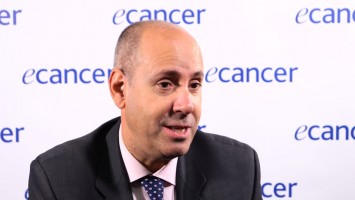Preventative effects of anastrozole in post-menopausal women who are at high-risk for developing breast cancer
Prof Jack Cuzick - Queen Mary University of London, London, UK
About five years ago we reported on the first results from the IBIS-II prevention trial which used the aromatase inhibitor anastrozole to try to prevent cancer before it occurred in postmenopausal women. The results were good but the follow-up was only five years and there was no long-term follow-up for aromatase inhibitors for prevention. Recently we showed that tamoxifen if you give it for five years the benefits last at least twenty years but they’re only about 30% per year. So we looked at this and we saw about a 55% effect previously. We’ve now updated the data out to about twelve years and to our great pleasure and excitement the results are maintained quite strong right out to twelve years. So there’s about a 60% reduction in the first five years and then another 36% year on year after that. So even in the longer-term follow-up it’s still working better than tamoxifen so we’re excited about that.
How did you stratify risk in patients?
We have a complicated algorithm but basically simply the most common way to become high risk is to have a mother or sister who had a breast cancer below the age of 50 or two breast cancers in the family or dense breasts, which wasn’t used so much, or atypical hyperplasia on a benign lesion.
Were there any adverse events?
One of the things we were very pleased about, one of the concerns about aromatase inhibitors is that they lead to higher fracture rates. Now, in this trial we made sure everybody had a DEXA scan to look at their bones before they started and if they were osteoporotic or osteopenic insisted that they take a bisphosphonate to control their bones. So there was a small increase of risk in fractures in the five years of active treatment, about 10%, and it’s now virtually completely gone. There are fewer fractures in the follow-up period so overall there’s virtually no increase in fractures so that was very good.
The other thing about aromatase inhibitors is that they do cause aches and pains and arthralgias. We haven’t looked at that in long-term follow-up because that’s basically only done in a clinic visit and generally if you’re going to get that you know about that in a year or two. So we haven’t looked at that any further but there are no other long-term side effects that are negative – no increase in other cancers, no increase in deaths from other causes, no increase in heart disease. The only other thing we found which is quite surprising, was that we found a substantial increase in non-melanoma skin cancer, about a 50% reduction there as well. That’s not a very serious cancer but it is of interest that that actually was clearly happening.
What are the take-home messages?
Anastrozole got in a little bit late in the game for prevention so it has not been formally licensed for prevention because that has to be done by the companies and because the drug is off patent there is no desire to do that. But in the UK it has been recommended by NICE and in the United States by the United States Preventive Services Task Force. So that just happened in 2017 so there’s still some concern about side effects.
The other interesting thing is we found that if we looked at the proportion of women who completed five years of treatment it was 77% on placebo but 74.6% or just slightly lower in the anastrozole arm, indicating that most of the reasons for stopping treatment were not side effects but for other reasons. So that was one of the main concerns about side effects but in fact a similar number of women managed to carry on with the treatment on the active arm.
Which drug is better suited to which type of patient?
The aromatase inhibitors, including anastrozole, are only suitable for postmenopausal women. So for premenopausal women it’s still Tamoxifen is the drug of choice. For postmenopausal women the benefits in terms of breast cancer reduction are much bigger for anastrozole. There aren’t the serious side effects like endometrial cancer or deep vein thrombosis which are seen with Tamoxifen occasionally so there appear to be no really serious side effects. The only concern is about arthralgia. So women that have a lot of trouble with that might not want to but we would think it’s the drug of first choice for every woman, virtually every woman, and if they can’t tolerate it then Tamoxifen would be the second choice.
What are the next steps?
The next steps are it’s still too early, even with twelve years of follow-up, to look at mortality. We’ve had three deaths in the placebo arm and two deaths in the anastrozole arm from breast cancer and overall the deaths are split, there are about 70 in each arm. So we need another ten years’ follow-up to see whether or not these reductions in incidents will translate into reductions in mortality. I’m optimistic they will but you never know until you’ve actually done the data. So those will be the next steps.
There are also a range of biomarker studies to be done to try to understand a bit better who is responding best to anastrozole and ideally identifying who is likely to have the side effects.
Anything else you’d like to add?
That’s good. The bit on compliance is really important. I said a bit about that, or adherence is the proper word. But in fact only 2.5% more women didn’t complete their five years of treatment compared to the placebo arm indicating that most of these side effects are really relatively short-term and tolerated. They tend to be tolerated within 3-6 months, you don’t see much after that that’s new.








